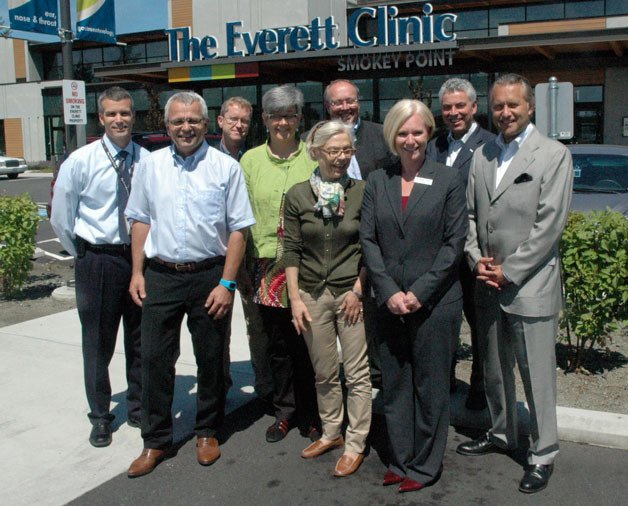BY KIRK BOXLEITNER
kboxleitner@marysvilleglobe.com
SMOKEY POINT — With as controversial as certain aspects of health care have become in the United States, it might be surprising to some to hear a distinguished group of medical professionals from overseas say that they need to consider more of an American approach to health care in their own country, but the members of a University Hospital Zurich study tour told The Marysville Globe and The Arlington Times exactly that during their July 16 visit to the Everett Clinic in Smokey Point.
The University Hospital Zurich is one of the largest and most important teaching hospitals in Europe, and is already considering how it will invest approximately $3 billion for the reconstruction of its campus over the course of the next 15 years. To that end, several members of its leadership team visited the Everett Clinic’s Smokey Point Medical Center for what they saw as its efficiency, flexibility and patient-focused environment.
Among the more vocal visitors with the press were Daniel Joseph Walker, managing partner of the Walker Project consultants to the University Hospital Zurich, and Peter Bodmer, delegate of the Zurich Government for the new University Hospital Zurich/BEKA Global Solutions. Walker noted that the study party had already toured through highly regarded hospitals in the Northeastern U.S., including Johns Hopkins in Maryland, in addition to Virginia Mason in Seattle.
“This is a good facility,” Walker said of the Smokey Point Medical Center. “Quality care depends a lot on quality processes. Shaky processes can lead to patient stress. The patient-centered approach here is good, and it’s translated through the architectural design of this facility.”
Bodmer agreed with Walker that the University Hospital Zurich’s planned overhaul within its current limited real estate makes such streamlining essential, especially as they expect to incorporate new state-of-the-art technologies into the revamped facility.
“We have a university, a hospital and a technology center all in one area, in the middle of the town,” Bodmer said. “It’s like if Johns Hopkins and MIT were on the same campus. In our country, health care is seen as an art form, not a business, so we don’t tend to talk about its costs as a business, but while we offer high-end medical care, that might not be the most efficient way of doing so. We’re sill a very federalist country, but we’re thinking more about strategy now, because not every hospital can do everything. We come here because we don’t want to have to reinvent the wheel. You understand what works and what doesn’t.”
The Everett Clinic’s Smokey Point Medical Center had already drawn attention for its patient-centered design as one of 12 projects recently selected by the American Institute of Architects for its National Healthcare Design Awards, for providing comprehensive care in a single community location and reducing wait times for patients.
“We were impressed by the beautiful facilities, and how they were designed to meet patients’ needs, and to optimize the flow of patients, staff and logistics,” said Bruno Letsch, CEO of the Bienne General Hospital in Switzerland. “Even more impressed we were by the team spirit, and the way the management system is lived and transformed from the strategic level down to the front line.”
The building has been touted for its use of space, which allows the Smokey Point Medical Center to make the most of lean workflow techniques. There are no waiting rooms, and blood draws and EKGs are brought to the patient in the exam room.
The University Hospital Zurich study tour joined a steady stream of local healthcare providers and groups from other states who have visited the facility to get ideas for their own clinics, including the University of Michigan and Nemours Clinics.
“They see how the building design and established standard workflow supports an enhanced patient experience,” said Jon Sackett, director of the Smokey Point Everett Clinic’s Improvement System, which works to improve workflow and reduce waste. “They also walk the patient visit process, and learn from Smokey Point staff and provider teams about what makes it successful.”


